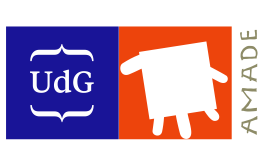
18 Sep Participation in the EURADH / WCARP 2023 international conference
Researchers of AMADE participated in the 14th European Adhesion Conference (EURADH) & 7th World Congress on Adhesion and Related Phenomena (WCARP), held in Garmisch-Partenkirchen (Germany) on September 10-13, 2023.
Specifically, Edwin Meulman, PhD student of AMADE under the supervision of Dr. Jordi Renart, gave an oral presentation entitled “Design of an energy release rate-controlled mode I creep crack growth rate test method for adhesively bonded joints”, coauthored with researchers of AMADE – University of Girona (Jordi Renart and Laura Carreras) and Ikerlan Technology Research Centre, Basque Research and Technology Alliance – BRTA (Javier Zurbitu).
The background of this research is the importance of understanding the long-term behavior of an adhesive for the design of durable bonded joints. Viscoelastic creep crack growth affects the durability of a bonded joint and should be considered when designing a bonded joint.
A novel method was developed to obtain the creep crack growth rate (da⁄dt) as a function of the energy release rate (G). The Roller Wedge Driven (RWD) creep crack growth methodology can produce creep crack growth rate curves for a constant applied energy release rate. The RWD test method makes use of a roller wedge that loads DCB-like specimens in mode I. By changing G for different specimens and measuring the creep crack growth rate over time, a G vs. da⁄dt curve can be obtained. Plotting the curve on a log-log scale shows a linear regression line of the G vs. da⁄dt curve similar as the Paris law. The Paris law is incorporated in most commercially available FEM software for simulating fatigue crack growth. Since the tested specimens in this work follow a Paris-like behavior for creep crack growth, it could be possible to use existing fatigue modules to simulate creep crack growth in a bonded joint.
Experimental test results in this work demonstrate that creep crack growth can already occur at relatively low energy release rates compared to the fracture toughness of the adhesive found by quasi-static testing. Not considering time dependent mechanisms, like creep crack growth, and only using data from quasi-static testing will very likely overestimate the durability of the bonded joint.
The presented research is part of the following two published papers, which are open access:
“Analysis of mode I fracture toughness of adhesively bonded joints by a low friction roller wedge driven quasi-static test”. E. Meulman, J. Renart, L. Carreras, J. Zurbitu. Engineering Fracture Mechanics, Volume 271, 108619, 2022. Link:
https://www.sciencedirect.com/science/article/pii/S0013794422003502?via%3Dihub
“A methodology for the experimental characterization of energy release rate-controlled creep crack growth under mode I loading”. E. Meulman, J. Renart, L. Carreras, J. Zurbitu. Engineering Fracture Mechanics, Volume 283, 109222, 2023. Link:
https://www.sciencedirect.com/science/article/pii/S0013794423001807?via%3Dihub
The authors would like to acknowledge the support of the Spanish Government through the Ministerio de Ciencia, Innovac´on y Universidades under the contract PID2021-127879OB-C21 and Grant RYC2021-032171-I funded by MCIN/AEI/ 10.13039/ 501100011033 and by “European Union NextGenerationEU/PRTR. The first author would also like to acknowledge the support received from the Universitat de Girona and Banco Santander through the fellowship grant IFUdG2021-AE, co-funded by the AMADE research group (GRCT0064). Open Access funding provided thanks to the CRUE-CSIC agreement with Elsevier. The work in this research has been made possible by patent 300352094, PCT/ES2020/070074 made available by IKERLAN, S.COOP. (IKER018) and the Universitat de Girona. Furthermore, the authors like to acknowledge the support from the AMADE research group testing laboratory.




